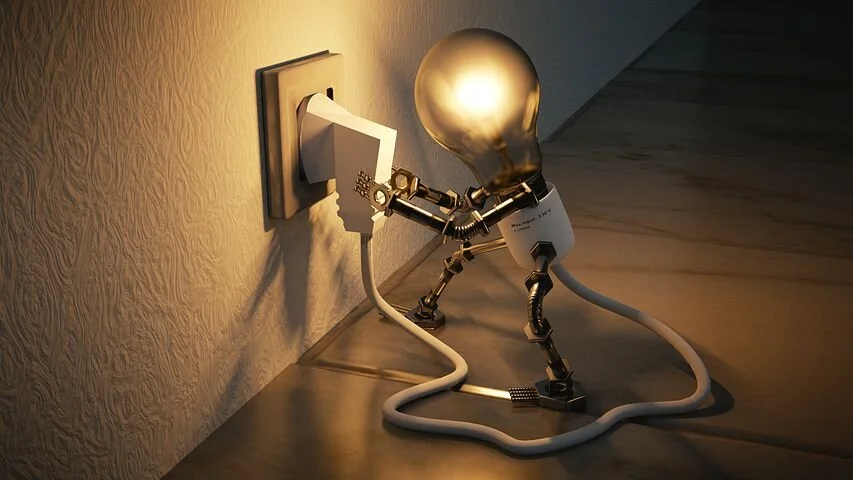Misunderstood and misinterpreted concepts circulate the world of EMF remediation consulting, especially those involving earthing, grounding, and bonding. Hopefully, this article will help you gain an improved working knowledge of these terms.
To begin, let's define the term electrical conductor. An electrical conductor is any metal wire that can provide a guiding path for electricity to flow. Of course, humans are not electrical conductors in this sense, but we are conductors of electricity. Current can travel across the epidermis and through our bodies. When either a ground rod, also termed a grounding electrode, or a human being connects directly to the Earth, we call this Earthing.
Are you connected to the electrical system or the Earth?
The frost line is 30 inches below Earth ground's surface. Everything above this imaginary line becomes wholly frozen during the winter months. This top layer of Earth's skin is also where most stray voltage and current traverse, especially when the soil is moist. This energy comes from nearby electrical power lines, substations, underground cabling, and electrojets formed via solar flares passing through the ionosphere that couple to the secondary windings of transformers to produce odd harmonics to the 13th order.
Ubiquitous modern-day microwave communication signals couple to all lower frequency energies resulting in fast transient harmonics running over the Earth’s surface. These transients need to be compensated for while conducting soil resistivity tests by using low pass filters.
With lower temperatures or high-frequency ground currents, soil resistivity increases, potentially raising a grounding electrode's impedance. The NFPA 70E® required impedance for a grounding electrode to function appropriately is 25 ohms or less, except in particular circumstances when sensitive electronics are involved, where 5 ohms is required. Power stations will require 0.5 ohms (IEEE 1.9.5)
(NEC 250.54 (A) states: "A single electrode consisting of a rod, pipe, or plate that does not have a resistance to ground of 25 ohms or less shall be augmented by one additional electrode of any type specified in section NEC 250.52 (A) (4) - (a)(8).)" To achieve this target of 25 ohms or less, we need to drive an eight-foot ground rod beyond this thirty inches until the rod's top is either level or just below the surface (NEC 250.53 (G.)
(Depending on the soil resistivity, you may need more than one eight-foot ground rod inserted to a deeper calculated depth than eight feet or apply alternative methods using ground rings, ground plates, or ground trenches. Each of these electrodes must be a minimum depth of 30 inches (NEC 250.53 (F)(G)(H).) Note: Elexana LLC is certified to make these determinations and calculations.
To protect our buildings from high-voltage lightning strikes, line surges, or unintentional contact with high-voltage lines (NEC 250.4 (A)(1)), a low impedance grounding electrode is required to provide an effective ground-fault path to Earth. NEC 250.66 (A) requires either a 6 AWG copper wire or a 4 AWG aluminum wire for the grounding electrode conductor fastened with a copper or galvanized clamp to connect the ground rod with the ground/ neutral busbar inside the Mains electrical panel. (Some panels have separate ground and neutral busbars connected via a bonding screw (often painted green) or a bonding strap.) The neutral return wires (usually gray or white) from every branch circuit in your building and all ground conductors (green wire) from every wall outlet receptacle eventually connect to the Mains neutral busbar. The neutral busbar's return conductor connects through your electrical service entry back out to your power company's transformer. The transformer is the drum on the telephone pole if you have overhead distribution lines or the metal cabinet near your front lawn if you have underground distribution lines.
To further protect your building from a catastrophic lightning strike, NEC 250.104 requires bonding all water and gas pipes. Bonding means connecting all metal piping and structural steel (NEC 250.52 (A)(2)) and linking them back to the grounding electrode. All raceways (NEC 250.96) and metal cabinets such as your refrigerator, stove, washer and dryer, toaster oven, etc., must be grounded/bonded via the ground conductor pins on their plugs to the wall outlet ground socket (NEC 250.114.) (Note: This connection also protects you from a shock hazard in case of a short by initiating the GFCI, Ground Fault Circuit Interrupter, or your circuit breaker to flip.) The term "grounding" means connecting your appliances and devices to the Equipment Ground Conductor, EGC, to your Mains panel neutral busbar, then out to the grounding electrode.
The Earth does not provide ample protection from a lightning strike, so the final protection from a lightning strike is the overload ground conductor connecting your neutral busbar to your water service pipe in your basement near to where it enters your building. The excess voltage will travel from your water pipe, "leap" over your water meter via a jumper and continue onto the municipal water supply, absorbing all extra voltage.
Many folks have the false notion that the grounding conductor in their home or office is some pristine connection to Earth. This idea could not be further from reality. Even if you powered down your building altogether, you would have a voltage and current on your grounding conductor. Depending on radio frequency interference and the condition of your local transformer, you will have a wide bandwidth of harmonics (dirty electricity) on this conductor and your neutral conductor, as well.
Some clients who wish to "ground" themselves from their office or home have asked if they could drive a separate independent ground rod into the Earth and not connect it to the Mains panel. We can't endorse this practice because NEC 250.50 requires bonding for all grounding electrodes. Remember, this code is to protect you. Further, without adequately testing your soil resistivity, your temporary ground rod may very well be corrupted by stray voltage and current traveling along the surface of the ground. Additionally, this cable's impedance is too high for anything like a negative ion to travel from Earth ground back to you.
Earthing can provide real health benefits. Not only will earthing shunt unwanted voltage from your epidermis, but the Earth contains negative ions, which can have a restorative and therapeutic effect. Negative ions are naturally occurring molecules holding a negative charge, extra electrons, correlated with alkalinity. Negative ions exist in ocean water, flowing streams, and clean air, especially after a thunderstorm. Negative ions also flow from sunlight and the Earth. Earth, of course, unless there is human-engineered stray voltage or current traveling along its surface.
If you live in a city or suburb, then most likely you are not earthing when you walk barefoot in your backyard. You would certainly not be earthing if you walked down the sidewalks of most New York City streets. Because concrete is conductive, walking barefoot in NYC would often have the opposite effect of earthing. With human-engineered electromagnetic radiation leakage from local electrical distribution lines traveling just below the sidewalk’s surface line, you can take on positively charged ions. Also, this activity could pose a potential shock hazard if a nearby utility is shorted.
If you want to know if you are genuinely earthing, verify the soil resistivity. (Note: If you are within a power-dense electromagnetic field, although earthing will bring your relative potential to zero millivolts (skin-body voltage), all energies will still couple to the epidermis. In other words, earthing shunts voltage but does not block electromagnetic energy.)
In summary, earthing occurs when we directly connect to the Earth, grounding, when we join a conductor to the electrical system ground/neutral busbar, and bonding, when we connect metal casings and pipes to the system ground/neutral busbar.
We all need to experience Nature as often as is possible, get plenty of sunlight, fresh air, and move our bodies throughout the day. Swimming in the ocean and walking on a beach provide earthing benefits. In contrast, grounding to your electrical system is not earthing. I encourage you not to be so naive about every alternative therapy and remedial device, no matter how many positive reviews and endorsements.
*If the grounding electrode is encased in concrete, then a 4 AWG copper wire is required (NEC 250.66 (B))




